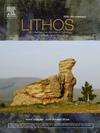印度东南部卡里姆纳加尔∼2.5 Ga弧相关岩浆焦绿泥石的起源及其对达瓦尔克拉通构造组装的影响
IF 2.9
2区 地球科学
Q2 GEOCHEMISTRY & GEOPHYSICS
引用次数: 0
摘要
在印度半岛,南印度地块(SIB)中的辛格布姆(Singhbhum)、巴斯塔(Bastar)和达尔瓦(Dharwar)板块构成了一个连续的2.5 Ga结晶岩群。这些板岩自起源以来是作为一个连贯的演化块体发展起来的,还是这些板岩构成了不同演化板岩的集合体?位于东达尔瓦克拉通(EDC)东北边缘的卡里姆纳加尔花岗岩带和相关的爆破花岗岩中的变异变形夏洛克岩含有黑云母花岗岩、高铝玄武岩和安山岩石英长片麻岩。炭质岩显然是飞地岩套的侵入体。飞地岩套呈现出陡峭的倾斜褶皱;褶皱的轴向平面与卡里姆纳加尔岩石/花岗岩中的N向构造结构相吻合。褶皱充填岩显示出岩浆流纹理,由正长石碱长石组成,含有正长-次正长辉石表晶,石英颗粒显示出丰富的棋盘状微结构。长石和辉石表晶的弱应变八面体板条之间以及与石英之间共享高能边界。根据Al-in-Opx测温法,岩浆角闪石的置换温度为900 °C。大部分岩石的整体化学成分与弧相关起源一致。在烧灼岩中的锆石中,不同分带的岩心得出的年龄分别为 2680 ± 15 Ma 和 2504 ± 12 Ma(UPb Concordia 图)。锆石晶粒中的再结晶域产生的上截距年龄被推定在 2510 ± 4 Ma 和 2509 ± 3 Ma 之间,与从独居石中获取的 U-Th-Pb 化学年龄(2502-2508 Ma)相同。锆石的εHf(t)值(- 4.85 至 1.31)表明,2.5 Ga以下的岩浆角闪石来源于3.0 Ga的地壳。EDC边缘的新元古代晚期岩浆角砾岩是在2.7-2.5 Ga的收敛构造环境中形成的,高T岩浆角砾岩是由俯冲(东西向缩短)的洋壳分层形成的。这种俯冲作用可能与新元古代晚期达瓦克拉通的生长有关,涉及到不同演化的地壳块体的组装,这些块体现在是达瓦克拉通的一部分。研究结果表明,卡里姆纳加尔岩浆角闪岩在收缩环境中的形成与早期工作者提出的东达鲁尔和巴斯塔陨石坑之间的增生无关。本文章由计算机程序翻译,如有差异,请以英文原文为准。
The origin of ∼ 2.5 Ga arc-related magmatic charnockites of Karimnagar, SE India, and implications for tectonic assembly in the Dharwar craton
In the Indian peninsula, the Singhbhum, Bastar, and Dharwar cratons in the South India Block (SIB) constitute a contiguous mass of >2.5 Ga crystalline rocks. Did the cratons develop as a coherently evolved mass since their origin, or do these cratons constitute an assembly of disparately evolved cratons? Variably-deformed charnockites in the Karimnagar granulite belt and associated blastoporphyritic granitoids at the NE fringe of the Eastern Dharwar Craton (EDC) contain enclaves of mafic granulites, high-Al metapelites and anatectic quartzofeldspathic gneisses. The charnockites are demonstrably intrusive into the enclave suite. The enclave suite exhibits steeply-plunging reclined folds; the axial planes of the folds coincide with the N-striking tectonic fabrics in the Karimnagar charnockite/granitoids. The foliated charnockites display magmatic flow texture defined by trains of euhedral alkali feldspar, contain euhedral-subhedral pyroxene phenocrysts, and the quartz grains exhibit abundant chessboard microstructure. The weakly-strained euhedral laths of feldspars and pyroxenes phenocrysts share high-energy boundaries between themselves, and with quartz. Emplacement temperatures of the magmatic charnockites at ∼900 °C are obtained from Al-in-Opx thermometry. Whole rock chemistry is consistent with an arc-related origin for most charnockites. In zircons within charnockites, variably zoned cores yield ages of 2680 ± 15 Ma and 2504 ± 12 Ma in the U![]() Pb Concordia plot. Recrystallized domains in zircon grains yielded upper intercept ages constrained between 2510 ± 4 Ma and 2509 ± 3 Ma, identical with the U-Th-Pb chemical ages (2502–2508 Ma) retrieved from monazites. The zircon εHf(t) values (− 4.85 to 1.31) suggest the ∼2.5 Ga magmatic charnockites were derived from <3.0 Ga crustal sources. The late Neoarchean magmatic charnockites in the EDC margin were emplaced in a 2.7–2.5 Ga convergent tectonic setting, and the high-T magmatic charnockites formed due to delamination of a subducting (E-W shortening) oceanic crust. The subduction possibly relates to the late Neoarchean growth of the Dharwar craton involving the assembly of disparately-evolved crustal blocks, now parts of the Dharwar craton. The findings suggest that the emplacement of Karimnagar magmatic charnockites in a contractional setting is unrelated to an accretion between the Eastern Dharwar and the Bastar cratons, as suggested by earlier workers.
Pb Concordia plot. Recrystallized domains in zircon grains yielded upper intercept ages constrained between 2510 ± 4 Ma and 2509 ± 3 Ma, identical with the U-Th-Pb chemical ages (2502–2508 Ma) retrieved from monazites. The zircon εHf(t) values (− 4.85 to 1.31) suggest the ∼2.5 Ga magmatic charnockites were derived from <3.0 Ga crustal sources. The late Neoarchean magmatic charnockites in the EDC margin were emplaced in a 2.7–2.5 Ga convergent tectonic setting, and the high-T magmatic charnockites formed due to delamination of a subducting (E-W shortening) oceanic crust. The subduction possibly relates to the late Neoarchean growth of the Dharwar craton involving the assembly of disparately-evolved crustal blocks, now parts of the Dharwar craton. The findings suggest that the emplacement of Karimnagar magmatic charnockites in a contractional setting is unrelated to an accretion between the Eastern Dharwar and the Bastar cratons, as suggested by earlier workers.
求助全文
通过发布文献求助,成功后即可免费获取论文全文。
去求助
来源期刊

Lithos
地学-地球化学与地球物理
CiteScore
6.80
自引率
11.40%
发文量
286
审稿时长
3.5 months
期刊介绍:
Lithos publishes original research papers on the petrology, geochemistry and petrogenesis of igneous and metamorphic rocks. Papers on mineralogy/mineral physics related to petrology and petrogenetic problems are also welcomed.
 求助内容:
求助内容: 应助结果提醒方式:
应助结果提醒方式:


